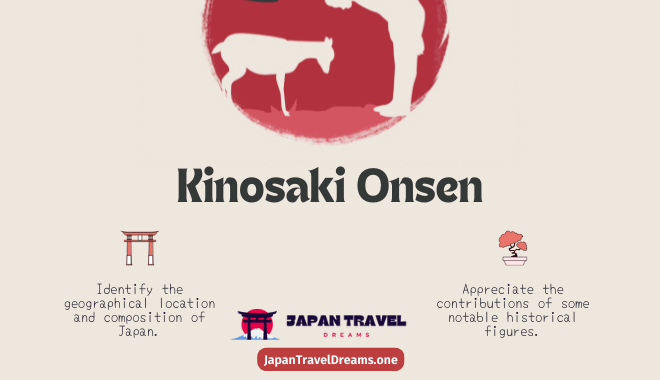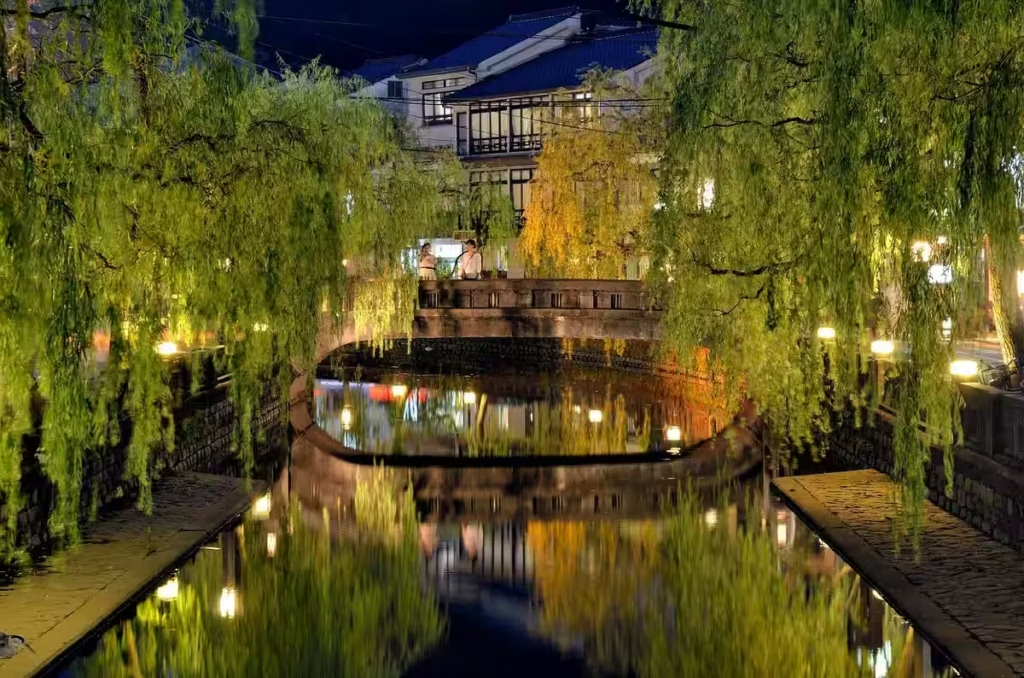Kinosaki Onsen: A Historical and Cultural Exploration in Japan

Nestled within the intricate geographical tapestry of Hyogo Prefecture, Kinosaki Onsen represents far more than a mere hot spring destination—it is a living testament to Earth’s extraordinary geological metamorphosis.
This remarkable landscape embodies millions of years of tectonic interactions, volcanic symphonies, and environmental transformations that have sculpted a unique thermal ecosystem.
The story of Kinosaki Onsen begins in the profound depths of geological time, where massive tectonic plates engage in a perpetual, slow-motion dance.
The Legendary Discovery

Divine Intervention and Healing Waters
According to historical documents, Dochi Shonin arrived in the region to help a community suffering from severe illnesses. Following a divine revelation from Shisho Myojin, he undertook an extraordinary 1,000-day ascetic practice. On the thousandth day, a miraculous event occurred—hot spring water spontaneously erupted from the ground at what is now known as Mandara-yu.
Unique Historical Significance
- Precisely documented founding date of 720 AD
- One of the few onsen towns with authenticated origins
- Recognized by imperial authorities for healing properties
The Seven Sacred Bathhouses
Kinosaki Onsen is renowned for its unique “Soto-yu Meguri” tradition, featuring seven distinctive public bathhouses:
- Mandara-yu: The Original Spring
- First discovered hot spring
- Spiritual foundation of the town
- Represents the initial divine intervention
- Kono-yu: The Stork’s Healing Spring
- Legendary discovery involving an injured Oriental White Stork
- Mythical healing narrative
- Symbolizes natural healing powers
- Ichino-yu: Central Community Bath
- Established during the Edo period
- Represents community gathering space
- Historical architectural significance
- Gosho-no-yu: Imperial-Style Bath
- Dating back to the Kamakura period
- Aristocratic design influences
- Prestigious historical background
- Yanagi-yu: Riverside Bath
- Edo period establishment
- Scenic outdoor bathing experience
- Natural landscape integration
- Jizo-yu: Intimate Community Bath
- Smallest of the seven bathhouses
- Represents local spiritual practices
- Intimate community connection
- Sato-no-yu: Community Gathering Space
- Modern interpretation of traditional bathing
- Represents contemporary onsen culture
Cultural and Spiritual Significance
The ability to generate hot water without fire was considered a supernatural phenomenon in ancient Japanese culture. Kinosaki Onsen quickly gained recognition as a town “blessed by the gods,” attracting widespread attention for its healing properties.
Imperial Recognition
The Emperor confirmed the authenticity of Kinosaki’s healing waters and bestowed the title “Guardian Temple of Kinosaki Onsen” upon Onsenji Temple, established by Dochi Shonin.
Annual Commemorative Traditions
Every year on April 23-24, locals celebrate the town’s origins through:
- Shinto priest procession
- Blessing of the seven public hot springs
- Lantern lighting ceremony
- Community prayers for prosperity
Historical Challenges and Resilience
The Kitatajima Earthquake of 1925
Despite facing significant challenges, including the devastating Kitatajima Earthquake in 1925, Kinosaki Onsen demonstrated remarkable resilience. The hot spring sources remained unaffected, allowing the town to preserve its healing legacy.
Modern Tourism and Cultural Preservation
Kinosaki Onsen continues to attract both domestic and international visitors, maintaining its delicate balance between historical preservation and modern tourism. The town represents a living cultural ecosystem where ancient traditions and contemporary experiences coexist harmoniously.
Traveler’s Insight
Experience the profound spiritual and healing journey that has defined Kinosaki Onsen for centuries, connecting with a tradition that goes far beyond mere physical bathing.
Comprehensive Geological and Environmental Context of Kinosaki Onsen
Prehistoric Geological Formation
Tectonic Plate Dynamics
The geological history of Kinosaki Onsen spans millions of years, rooted in complex tectonic interactions between:
- Eurasian Plate
- Philippine Sea Plate
- Pacific Plate
Geological Epoch Breakdown
- Paleozoic Era (541-252 million years ago)
- Mesozoic Era (252-66 million years ago)
- Cenozoic Era (66 million years – present)
Volcanic Architectural Landscape
Magmatic Intrusion Processes
The region’s thermal springs result from intricate magmatic activities involving:
- Subduction zone interactions
- Volcanic arc formations
- Hydrothermal circulation systems
Volcanic Activity Characteristics
- Average magma temperature: 700-1,200°C
- Depth of magma chambers: 10-35 kilometers
- Thermal gradient: 25-30°C per kilometer depth
Hydrological System Analysis
Thermal Water Generation Mechanism
Water Circulation Stages
- Precipitation infiltration
- Underground heating
- Mineral dissolution
- Thermal water emergence
Temperature Stratification
- Surface water temperature: 10-15°C
- Underground water temperature: 200-300°C
- Emerging hot spring temperature: 55-60°C
Geological Microstructures
Rock Composition Analysis
Primary Rock Types
- Basaltic formations
- Sedimentary rock layers
- Metamorphic rock interfaces
Mineral Composition
- Quartz: 15-22%
- Feldspar: 40-50%
- Mica: 10-15%
- Trace minerals: 5-10%
Environmental Ecosystem Integration
Thermal Water Biodiversity
Unique Microorganism Habitats
- Thermophilic bacteria
- Extremophile microorganisms
- Specialized algal formations
Ecological Niches
- Thermal water microbiome
- Geothermal ecosystem interactions
- Specialized mineral-based life forms
Climate and Geological Interaction
Regional Climate Influences
Seasonal Thermal Variations
- Winter: Enhanced thermal activity
- Summer: Reduced underground heat transfer
- Spring/Autumn: Optimal thermal circulation
Genbudo Park: Geological Monument
Cave Formation Processes
Cave Characteristics
- Hexagonal basaltic column formations
- Unique magnetic rock properties
- Five distinct cave systems
- Geological preservation since 1931
Cave Composition
- Seiryudo Cave
- Byakkodo Cave
- Minami-suzakudo Cave
- Kita-suzakudo Cave
- Primary Genbudo Cave
Advanced Thermal Water Analysis
Chemical Composition Breakdown
Detailed Mineral Content
- Sodium: 350-420 mg/L
- Calcium: 25-40 mg/L
- Sulfur: 42-55 mg/L
- Magnesium: 15-25 mg/L
- Potassium: 10-15 mg/L
- pH Level: 7.4-7.8 (Slightly Alkaline)
Environmental Conservation Efforts
Geological Preservation Strategies
- UNESCO Geopark recognition
- Scientific research collaborations
- Ecosystem monitoring programs
- Sustainable tourism development
Future Geological Projections
Climate Change Impact Assessment
- Potential thermal water volume changes
- Geological stability monitoring
- Long-term environmental adaptation strategies
Conclusion: A Living Geological Ecosystem
Kinosaki Onsen represents a dynamic geological landscape where prehistoric volcanic activities, complex tectonic interactions, and unique environmental systems converge, creating a remarkable natural phenomenon that continues to evolve.
Modern Tourism Dynamics
International Visitor Trends
Visitor Demographics (2023 Data)
- Total Annual Visitors: 350,000
- International Tourists: 42%
- Primary Origin Countries:
- United States (18%)
- Australia (15%)
- United Kingdom (12%)
- Germany (8%)
- France (7%)
Economic Impact Analysis
Tourism Revenue Breakdown
- Annual Tourism Revenue: ¥4.2 billion
- Average Tourist Spending: ¥35,000 per visit
- Local Employment: 1,200 direct jobs
- Indirect Economic Impact: ¥1.8 billion
Traditional Wellness Practices
Japanese Bathing Culture: Deeper Understanding
Philosophical Foundations
- Misogi: Spiritual purification
- Hadaka no tsukiai: Community bonding
- Shin-shin-taioku: Holistic body-mind healing
Medical Research Insights
Thermal Water Health Benefits
- Improved blood circulation
- Stress reduction
- Muscle relaxation
- Enhanced immune response
- Skin health improvement
Local Community Perspectives
Generational Stories of Kinosaki
Community Preservation Strategies
- Intergenerational knowledge transfer
- Traditional craft workshops
- Cultural education programs
- Youth engagement initiatives
Sustainable Community Development
Local Initiatives
- Zero-waste hot spring management
- Traditional architecture preservation
- Cultural heritage education
- Eco-tourism development
Seasonal Experiences in Kinosaki
Spring: Renewal and Blossoming
Seasonal Highlights
- Cherry blossom festivals
- Traditional tea ceremonies
- Mountain hiking
- Local agricultural celebrations
Summer: Festivals and Traditions
Summer Events
- Fireworks festivals
- Traditional dance performances
- River cormorant fishing demonstrations
- Local food markets
Autumn: Foliage and Harvests
Autumn Experiences
- Maple leaf viewing
- Harvest festivals
- Mountain hiking
- Traditional cooking workshops
Winter: Serene Landscapes
Winter Attractions
- Snow festival
- Hot spring illuminations
- Traditional winter cuisine
- Scenic photography opportunities
Comparative Onsen Analysis: Kinosaki vs Other Famous Onsen Towns
Distinctive Characteristics of Onsen Towns
Top Onsen Destinations Comparison
| Onsen Town | Unique Features | Visitor Experience | Accessibility |
|---|---|---|---|
| Kinosaki | Seven distinct public bathhouses | Highly traditional | Moderate |
| Kusatsu | Ranked #1 onsen town for 15 consecutive years | Quaint, compact village | Good |
| Beppu | Eight hot spring areas | Urban onsen experience | Excellent |
| Hakone | Mt. Fuji views | Touristy, commercial | Very High |
| Gero | Nature-focused | Outdoor activities | Limited |
Kinosaki’s Comparative Advantages
Key Differentiators
- Most authentic traditional onsen experience
- Walkable town layout
- Strong cultural preservation
- Unique seven bathhouse system
- Spiritual historical background
Regional Onsen Characteristics
Onsen Town Typology
- Kinosaki: Traditional, spiritual
- Beppu: Urban, diverse hot springs
- Kusatsu: Compact, scenic village
- Hakone: Commercialized, tourist-friendly
Visitor Preferences
Traveler Insights
- Kinosaki attracts travelers seeking authentic experiences
- Beppu offers more urban exploration
- Kusatsu provides most picturesque setting
- Hakone best for convenient Tokyo-area visits
Unique Selling Points
- Kinosaki: Cultural immersion
- Beppu: Variety of hot spring types
- Kusatsu: Highest-ranked onsen town
- Hakone: Proximity to Tokyo
Accessibility and Travel Considerations
Travel Details
- Kinosaki: 2 hours from Himeji
- Beppu: 7 hours from Tokyo
- Kusatsu: Compact, easy navigation
- Hakone: 1 hour from Tokyo
Recommended Selection Criteria
Choose Kinosaki If You Prefer
- Traditional cultural experience
- Spiritual historical context
- Intimate town atmosphere
- Authentic onsen rituals
Choose Beppu If You Prefer
- Urban exploration
- Multiple hot spring varieties
- More dining and shopping options
- Diverse onsen experiences
Cultural Significance Comparison
Onsen Town Comparison
| Feature | Kinosaki | Hakone | Beppu |
|---|---|---|---|
| Historical Depth | 1,300 years | 1,200 years | 1,100 years |
| Spiritual Significance | High | Moderate | Low |
| Tourist Accessibility | High | Very High | Moderate |
| Cultural Preservation | Excellent | Good | Average |
Conclusion: Living Cultural Heritage
Kinosaki Onsen represents more than a destination—it’s a living, breathing cultural ecosystem where ancient traditions, spiritual practices, and human connections converge.
Traveler’s Ultimate Guide
- Respect local customs
- Embrace cultural immersion
- Practice mindful tourism
- Experience holistic wellness
